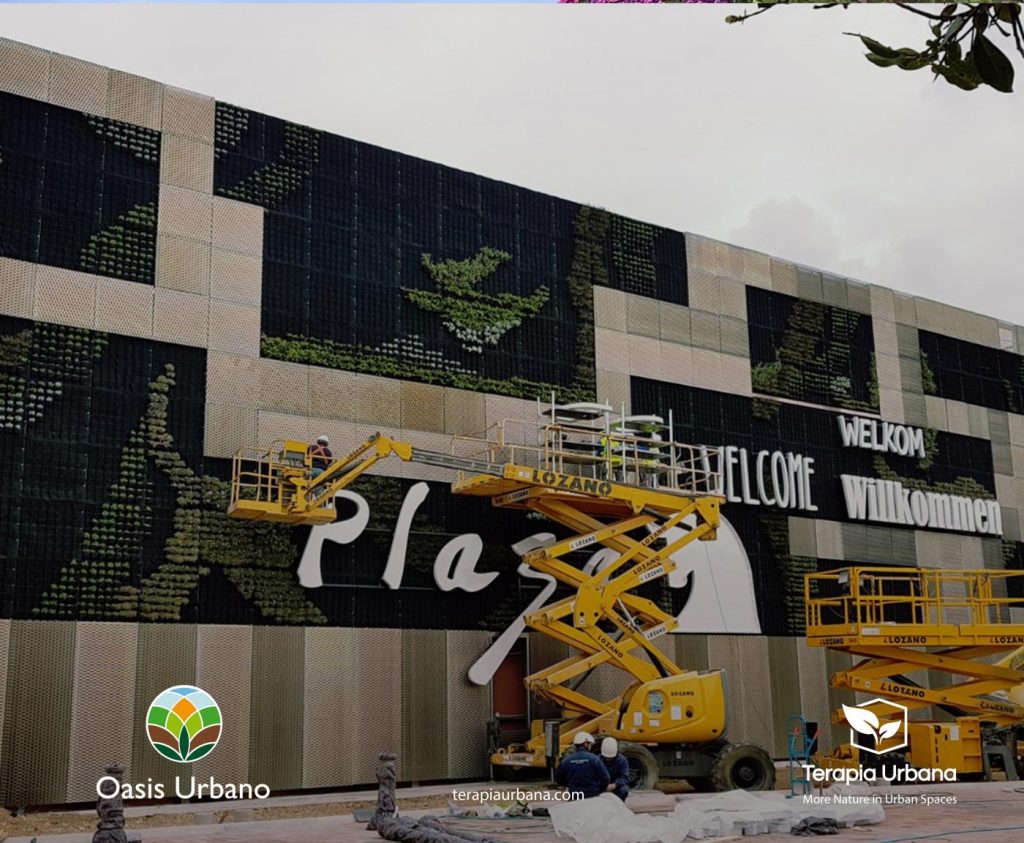Designing a vertical garden is integrating nature into your projects, devising and projecting a new construction taking into account the integration of a construction system that will bring numerous benefits in terms of sustainability and all that it entails.
In Terapia Urbana we have developed a modular system for vertical garden, which improves the development of the plant, it is our Fytotextile® system which, thanks to its versatility, can be adapted to the needs of each project in a personalized way.
To do this, we have a team specialized in developing tailor-made solutions for each green facade project or exterior garden roof, so that we design with nature, selecting the species that best adapt to each case after a detailed study of the determining factors.
Key aspects when designing
Sustainable Construction
Understanding sustainability as a balance between the natural, social and economic aspects. Sustainability is achieved through the installation of vertical gardens, making optimal use of resources, as well as taking into account the impact it may have on society or final benefits on people.
Improve energy efficiency
It is important to take into account how exterior vertical garden systems improve the energy efficiency of buildings. For quite a few years now, we have been working to build sustainable cities that can combat climate change, by integrating urban naturation systems into buildings. This integration makes it possible to achieve more efficient energy consumption and a better energy performance of the building, which translates into a significant reduction in CO2. We must not forget that the building is responsible for a high percentage of CO2 emissions due to poor conditioning and use of conditioning systems.
Vertical gardens have become a very interesting option to improve the thermal insulation of the envelope, constituting passive design tools for energy savings in buildings. When installed on exterior facades, they allow a significant reduction in the temperature of the exterior face, especially in hot seasons.
In addition, the vegetation present in these systems provides numerous benefits for the environment, such as the generation of oxygen, fixation of greenhouse gases (GHG). In this sense, and from an urban scale, the garden facades constitute an important instrument in the fight against global warming.
Value the benefits provided
It is very important to value the benefits that the vertical garden brings, and that we can divide into these categories:
- Improvements for the environment. The landscaped facades fulfill the function of improving the environmental quality of certain urban areas, providing oxygen, becoming biofilters capable of retaining greenhouse gases, heavy metals or volatile toxic components present in the air.
- Benefits for buildings. Vertical gardens provide improvements for the energy efficiency of buildings, thanks to the ability of the plant to maintain its constant temperature through its natural mechanism of evapotranspiration (evaporating water to maintain its constant temperature, so it will never be at a temperature higher than that of the air that surrounds it, achieving envelopes that function as natural regulators).Likewise, in interior spaces they modify the relative humidity, providing better air quality, which has a direct influence on the improvement of the sick building syndrome, which we have talked about on occasion.
- Benefits for people. In the end, improvements in the environment and air quality have a positive impact on people, providing improvements in productivity, well-being, happiness… something that, for companies, has a direct impact on improving the return on energy. investment through the implementation of these systems.
- Benefits for companies or institutions. The integration of these systems provides a clear improvement in the brand image of companies, by constituting a direct investment in Corporate Social Responsibility. This positive impact translates into an improvement in the customer’s perception and their shopping experience… in the end they establish a more human bond thanks to contact with nature, the need for biophilia and contact with the living… which it ends up becoming a reinforcement of the bond with the brand or institution. In order to give scale to this impact, some studies such as the one we carried out in collaboration with the University of Seville on the impact of the vertical garden of the Sagrado Corazón Hospital, installed in Seville in 2012, and which you can consult here.
Approach from the Life Cycle Assessment
When we approach the implementation of a system, we must take into account the Life Cycle Analysis (LCA), that is, take into account the consumption of resources that the system has had since it was conceived, installed, produced and, when the moment, withdraw. It is a measurement of the carbon footprint and the global impact that it will have on the building. When choosing a vertical garden system, it is important to be clear about its characterization in terms of durability, a determining factor if we talk about sustainability. For them it is important to review the certificates, tests or trials that each manufacturer can provide in this regard, which objectively define how the chosen system will evolve over time.
Do you need to integrate Nature into your project or design, through vertical gardens or green roofs? We provide you with the advice of our expert team in R+D+i in Urban Nature. How can we help you?
If what you read has been interesting for you, we encourage you to continue reading with our post on how to budget for a vertical garden in your project.
(Project: Outdoor living wall in Malaga Shopping centre. Collaborator: Urban Oasis)

